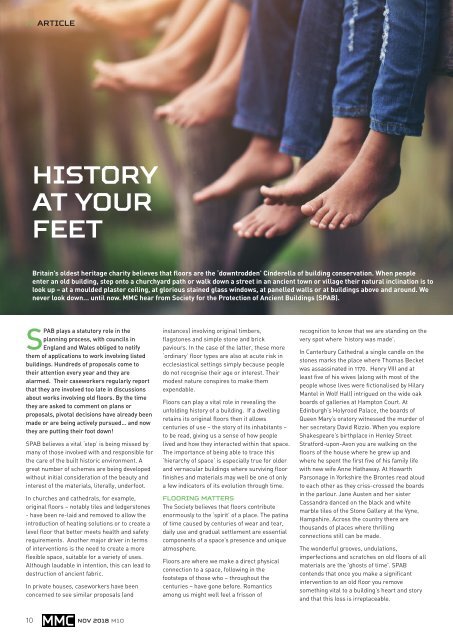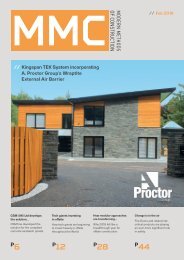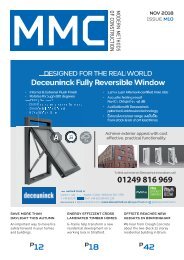Create successful ePaper yourself
Turn your PDF publications into a flip-book with our unique Google optimized e-Paper software.
article<br />
History<br />
at your<br />
feet<br />
Britain’s oldest heritage charity believes that floors are the ‘downtrodden’ Cinderella of building conservation. When people<br />
enter an old building, step onto a churchyard path or walk down a street in an ancient town or village their natural inclination is to<br />
look up – at a moulded plaster ceiling, at glorious stained glass windows, at panelled walls or at buildings above and around. We<br />
never look down… until now. <strong>MMC</strong> hear from Society for the Protection of Ancient Buildings (SPAB).<br />
SPAB plays a statutory role in the<br />
planning process, with councils in<br />
England and Wales obliged to notify<br />
them of applications to work involving listed<br />
buildings. Hundreds of proposals come to<br />
their attention every year and they are<br />
alarmed. Their caseworkers regularly report<br />
that they are involved too late in discussions<br />
about works involving old floors. By the time<br />
they are asked to comment on plans or<br />
proposals, pivotal decisions have already been<br />
made or are being actively pursued… and now<br />
they are putting their foot down!<br />
SPAB believes a vital ‘step’ is being missed by<br />
many of those involved with and responsible for<br />
the care of the built historic environment. A<br />
great number of schemes are being developed<br />
without initial consideration of the beauty and<br />
interest of the materials, literally, underfoot.<br />
In churches and cathedrals, for example,<br />
original floors – notably tiles and ledgerstones<br />
- have been re-laid and removed to allow the<br />
introduction of heating solutions or to create a<br />
level floor that better meets health and safety<br />
requirements. Another major driver in terms<br />
of interventions is the need to create a more<br />
flexible space, suitable for a variety of uses.<br />
Although laudable in intention, this can lead to<br />
destruction of ancient fabric.<br />
In private houses, caseworkers have been<br />
concerned to see similar proposals (and<br />
10 <strong>MMC</strong><br />
Nov 2018 <strong>M10</strong><br />
instances) involving original timbers,<br />
flagstones and simple stone and brick<br />
paviours. In the case of the latter, these more<br />
‘ordinary’ floor types are also at acute risk in<br />
ecclesiastical settings simply because people<br />
do not recognise their age or interest. Their<br />
modest nature conspires to make them<br />
expendable.<br />
Floors can play a vital role in revealing the<br />
unfolding history of a building. If a dwelling<br />
retains its original floors then it allows<br />
centuries of use – the story of its inhabitants –<br />
to be read, giving us a sense of how people<br />
lived and how they interacted within that space.<br />
The importance of being able to trace this<br />
‘hierarchy of space’ is especially true for older<br />
and vernacular buildings where surviving floor<br />
finishes and materials may well be one of only<br />
a few indicators of its evolution through time.<br />
Flooring matters<br />
The Society believes that floors contribute<br />
enormously to the ‘spirit’ of a place. The patina<br />
of time caused by centuries of wear and tear,<br />
daily use and gradual settlement are essential<br />
components of a space’s presence and unique<br />
atmosphere.<br />
Floors are where we make a direct physical<br />
connection to a space, following in the<br />
footsteps of those who – throughout the<br />
centuries – have gone before. Romantics<br />
among us might well feel a frisson of<br />
recognition to know that we are standing on the<br />
very spot where ‘history was made’.<br />
In Canterbury Cathedral a single candle on the<br />
stones marks the place where Thomas Becket<br />
was assassinated in 1170. Henry VIII and at<br />
least five of his wives (along with most of the<br />
people whose lives were fictionalised by Hilary<br />
Mantel in Wolf Hall) intrigued on the wide oak<br />
boards of galleries at Hampton Court. At<br />
Edinburgh’s Holyrood Palace, the boards of<br />
Queen Mary’s oratory witnessed the murder of<br />
her secretary David Rizzio. When you explore<br />
Shakespeare’s birthplace in Henley Street<br />
Stratford-upon-Avon you are walking on the<br />
floors of the house where he grew up and<br />
where he spent the first five of his family life<br />
with new wife Anne Hathaway. At Howarth<br />
Parsonage in Yorkshire the Brontes read aloud<br />
to each other as they criss-crossed the boards<br />
in the parlour. Jane Austen and her sister<br />
Cassandra danced on the black and white<br />
marble tiles of the Stone Gallery at the Vyne,<br />
Hampshire. Across the country there are<br />
thousands of places where thrilling<br />
connections still can be made.<br />
The wonderful grooves, undulations,<br />
imperfections and scratches on old floors of all<br />
materials are the 'ghosts of time'. SPAB<br />
contends that once you make a significant<br />
intervention to an old floor you remove<br />
something vital to a building’s heart and story<br />
and that this loss is irreplaceable.
















